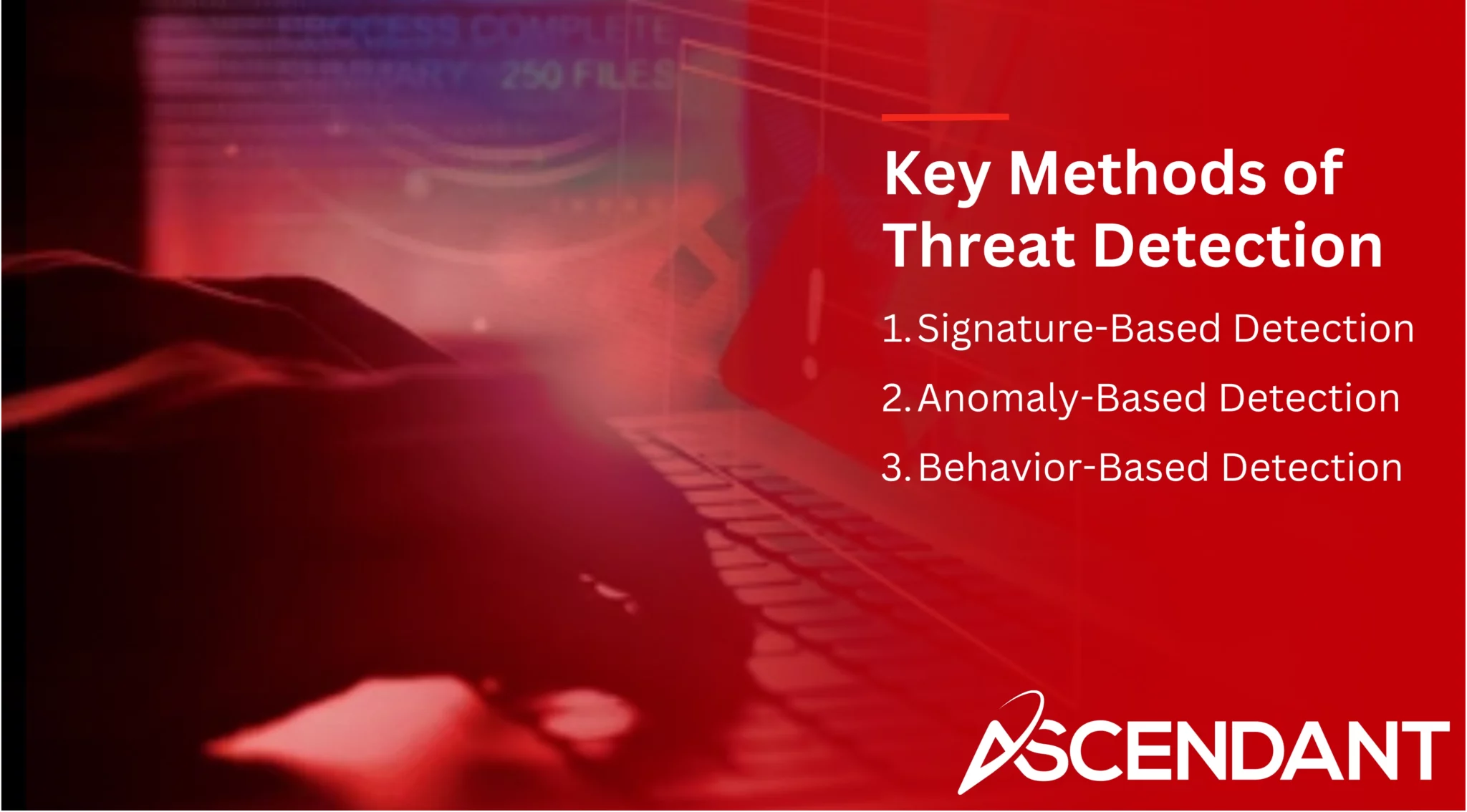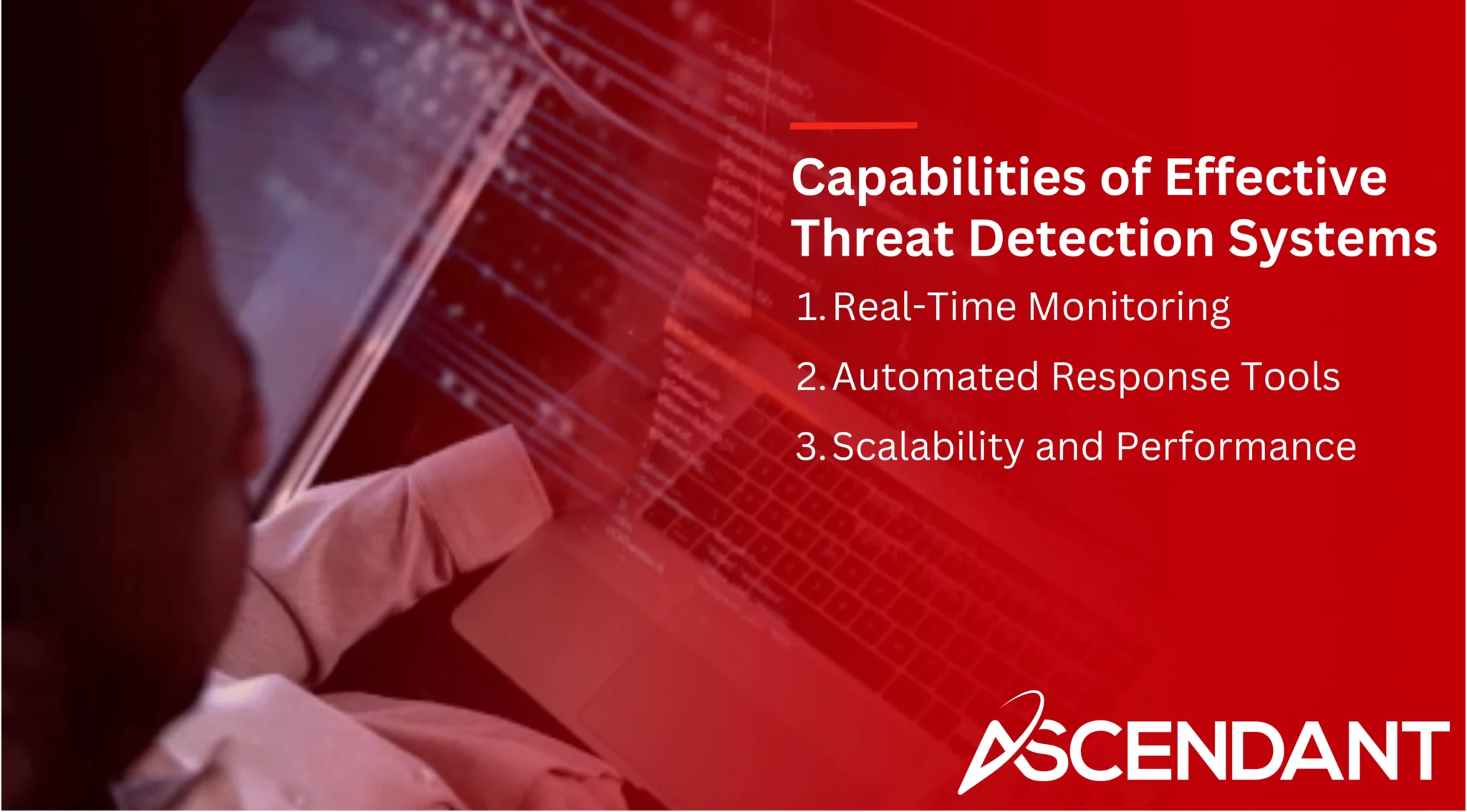What is threat detection, and how can it save your organization from cyber attacks? In this article, we’ll uncover the importance of threat detection, its key methods, and the tools you need to strengthen your cybersecurity defenses.
Key Takeaways
- Effective threat detection and response involves multi-layer defense strategies, including real-time monitoring and advanced security tools like SIEM and XDR.
- Key detection methods include signature-based, anomaly-based, and behavior-based detection, each addressing different aspects of threat identification.
- AI plays a pivotal role in enhancing threat detection capabilities, allowing for real-time analysis, automated responses, and predictive threat intelligence.
Understanding Threat Detection and Response
The capacity to detect and respond to threats is imperative for preemptively addressing security weaknesses that could be exploited by adversaries. This critical process encompasses numerous phases such as spotting, examining, containing, eliminating, recovering from incidents, reporting them appropriately, and taking steps to reduce future risks. To effectively counteract potential threats and bolster threat response strategies, effective threat detection employs a layered defensive approach coupled with constant real-time scrutiny and an array of overlapping security measures.
Essential elements in the realm of threat detection and response consist of uncovering cyber dangers before they lead to breaches while also strengthening defenses at endpoints. The deployment of tools like Security Information and Event Management (SIEM) systems alongside Extended Detection and Response (XDR) platforms augments oversight over organizational security environments—which is vital for swiftly detecting harmful activities. These sophisticated instruments are engineered not only against known hazards, but are also adept at warding off previously unknown cyber threats that exhibit stealthy behaviors.
To devise a robust strategy for effective threat detection requires comprehensive knowledge regarding sensitive information handling processes within the organization’s IT framework along with crucial operational procedures. Cyber threats manifest through diverse schemes including phishing expeditions, malware insertion, and ransomware assaults. Distributed denial-of-service (DDoS) attacks, internal actor betrayals, plus identity-based infractions necessitate powerful tools capable of thwarting complex aggressions by pinpointing signs indicative of system compromise. With advanced technologies in place, identifying perilous attempts or infiltrations can enact preventative measures—such actions include blocking suspicious IP addresses shutting down user accounts or sequestering compromised devices thus neutralizing hostile engagements.
Key Methods of Threat Detection
Various techniques are employed to pinpoint potential cyber threats, with each technique tackling distinct facets of threat recognition. Included among these methods are signature-based detection, anomaly-based detection, and behavior-based detection.
These strategies collectively serve as critical components in the early identification and neutralization of cyber threats, guaranteeing extensive security protection.
Signature-Based Detection
Intrusion detection systems employ signature-based detection by scrutinizing network traffic and matching it with established patterns of known malicious behavior to pinpoint threats. This technique relies on a database of threat signatures, enabling the rapid recognition of existing threats via pattern comparison, which is essential in many such security systems for promptly identifying familiar dangers.
Anomaly-Based Detection
Anomaly-based detection is a method that detects potential security threats by identifying irregularities from normal network traffic behavior patterns. This approach monitors actions within a network or application to pinpoint variations that could signify security threats.
Setting up a baseline for regular behavior allows anomaly-based detection systems to efficiently detect atypical activities which might suggest the presence of malicious activity.
Behavior-Based Detection
Behavior-based detection scrutinizes the actions of users and systems to pinpoint potential threats by recognizing established patterns of normal behavior. To successfully signal divergences that might indicate a threat, this strategy necessitates sophisticated analytics and comprehensive knowledge of typical behaviors.
Owing to its intricate nature, the utility of behavior-based detection is indispensable in spotting sophisticated attackers who are adept at bypassing conventional methods designed for detecting such incursions.
Advanced Threat Detection Techniques
Utilizing progressive security strategies is fundamental for advanced threat detection, which plays a critical role in the identification and mitigation of continuous malware risks. Key practices like machine learning, threat hunting, and leveraging threat intelligence are imperative tools that organizations must employ to outpace sophisticated attackers.
By blending conventional detection methodologies with advanced analytics, these techniques enable the discovery of not only familiar threats but also those previously unknown. This approach guarantees an all-encompassing defense mechanism against various cyber threats.
Machine Learning in Threat Detection
Machine learning algorithms enhance threat detection by recognizing patterns in large datasets, improving detection speed and accuracy. Advanced analytics powered by AI can identify patterns in user behavior, allowing for the early detection of potential security threats. Emerging AI technologies are expected to enhance the speed and accuracy of threat detection, addressing challenges in cybersecurity.
Anomaly-based detection utilizes machine learning to adaptively refine the baseline as it processes new data and identifies anomalies. Generative AI can sift through extensive datasets to identify unusual behaviors and detect malicious activities more effectively.
The future of AI in threat detection includes advancements in deep learning for better pattern recognition and faster data processing through quantum computing.
Threat Hunting
The practice of threat hunting entails a proactive search for threats that have penetrated an organization’s systems. It is executed by scrutinizing network traffic and monitoring actions to identify irregularities and detect continuous malicious activity.
Tools such as Sqrrl and Peak can support security administrators in conducting threat hunting activities, thus establishing it as a vital element within the arsenal of modern threat detection techniques.
Integration with Threat Intelligence
Regular updates to threat intelligence are essential for staying ahead of evolving cyber threats. Threat intelligence uses external threat intelligence feeds to identify known malicious entities, enhancing security measures in cloud threat detection systems.
Incorporating threat intelligence allows organizations to predict potential security threats based on observed patterns from various sources.
Examples of Cyber Threats
Cyber threats can be divided into two main categories. These include common cyber threats and advanced persistent threats. These threats pose significant risks to organizations, necessitating robust threat detection and response strategies. The rise of IoT devices has expanded the potential attack surface, as many devices lack adequate security measures.
Ransomware attacks have become more targeted and sophisticated, involving extensive reconnaissance prior to execution.
Common Cyber Threats
There are various forms of cyber threats that one may encounter, such as:
- Ransomware: This type of threat involves software that encrypts files on the victim’s system, denying access until a ransom is paid.
- Malware: A category encompassing different types of harmful software intended to harm data integrity or accessibility.
- DDoS attacks: These overburden networks or services with excess traffic, causing disruption in their usual activities.
- Phishing: Techniques used to masquerade as trustworthy communication in order to obtain sensitive information from an unsuspecting recipient.
Recognizing these threats is essential for preserving cybersecurity.
To safeguard against breaches and prevent the loss or theft of data due to these issues, it is necessary to employ effective strategies for detecting threats. Identifying potential dangers promptly allows for timely intervention before they can cause significant damage.
Advanced Persistent Threats
Attacks known as advanced persistent threats (APTs) involve establishing a long-standing infiltration in a network to achieve objectives such as cyber espionage, hacktivism, or monetary profit. APTs usually commence with the penetration of a network followed by the insertion of malicious software and the acquisition of credentials, culminating in data theft without being noticed.
The 2015 intrusion into U.S. government databases by DEEP PANDA serves as an illustration of an APT event where over four million personnel records were compromised.
Insider Threats
Insider threats can stem from both current and former employees who possess inside knowledge of the organization’s operations. These threats can range from negligent behaviors to malicious actions by employees.
Insider threats require robust threat detection and response mechanisms to mitigate the risk of sensitive data breaches.
Capabilities of Effective Threat Detection Systems
Continuous monitoring is essential for effective threat detection systems to pinpoint potential threats as they emerge. The vigilance of a security operations center (SOC) enhances cybersecurity, providing round-the-clock surveillance and reaction to any identified dangers.
In the realm of advanced threat detection and response, contemporary technologies and methodologies are employed alongside automated tools and approaches that prioritize human expertise. Effective threat detection programs encompass a broad scope including network events, security incidents, as well as endpoint detection occurrences.
Real-Time Monitoring
Enhancing threat detection capabilities can be achieved through the adoption of continuous monitoring. Continuous monitoring solutions play a vital role in sustaining vigilance over security occurrences within networks and systems, with AI-powered technologies supporting immediate monitoring and evaluation to promptly pinpoint atypical actions that might indicate breaches.
By actively engaging in threat hunting, potential hidden threats are uncovered by persistently surveilling network traffic for anomalous patterns.
Automated Response Tools
The utilization of artificial intelligence is critical for the automation involved in detecting and countering cyber threats. Thanks to AI’s capability for real-time processing, it significantly accelerates the analysis of data and improves the rapidity with which security incidents are responded to. The progression of AI technology promises improvements in predictive analytics along with self-governing capabilities in incident response.
Actions like quarantining systems or barring suspect IP addresses can be executed automatically as part of these automated responses.
Scalability and Performance
Efficiently handling substantial data quantities, scalable threat detection systems deliver precise identification of threats, thus minimizing the likelihood of false positives and improving response times.
By integrating scalable systems into threat detection strategies, operational efficiency is augmented alongside an increase in security effectiveness.
Best Practices for Enhancing Threat Detection
Organizations must employ persistent surveillance, routinely update their threat intelligence, and maintain consistent staff training to enhance their capacity for threat detection and response. Such practices are crucial for the immediate identification of security risks and weaknesses.
Regular Security Assessments
Organizations benefit from routinely carrying out security assessments to pinpoint and mitigate vulnerabilities before they become an exploitable threat. It is essential to consistently perform vulnerability scans and penetration tests in order to preserve a secure infrastructure.
By continuously undertaking frequent security evaluations, organizations can detect and remedy vulnerabilities preemptively, preventing potential exploitation.
Employee Training and Awareness
Continuous education programs play an essential role in raising employee awareness of cybersecurity, thereby sharpening their skills to identify threats. Consistent training workshops can greatly increase the staff’s proficiency in spotting phishing incidents and various malevolent actions.
By bolstering employee knowledge concerning cybersecurity risks through these programs, the general defensive stance of an organization against potential cyber threats is substantially strengthened.
Incident Response Planning
A security incident response plan is critical in delineating the necessary roles and procedures to manage a security event efficiently, aiming to minimize disorder when a breach occurs. This plan must explicitly outline measures for containment, elimination, and recuperation following security incidents.
For successful incident management, it’s imperative that there are well-established communication pathways and specified responsibilities among members of the security team during an event related to incident response.
Challenges in Threat Detection
As technology and defensive approaches advance, cyber threats also evolve in complexity, presenting notable difficulties in both identifying and countering these attacks efficiently.
Evolving Threat Landscape
Defenders often face considerable difficulty in identifying threats due to attackers’ constant evolution of strategies, aimed at evading detection. The plethora of data from numerous sources adds a layer of complexity to threat analysis. Employing clandestine techniques, Advanced Persistent Threats (APTs) are designed to secretly breach and persist within targeted networks over extended periods.
False Positives and Negatives
Distinguishing actual threats from mere noise presents significant operational challenges due to false positives in threat detection. This task not only consumes substantial time but also demands considerable resources for successful execution. To manage these false positives, it’s crucial to fine tune the detection systems and maintain continuous monitoring.
Resource Constraints
Tight financial constraints may result in organizations underfunding critical security tools and technologies, which can compromise the effectiveness of their threat detection capabilities. A shortfall in skilled security personnel hinders an organization’s capacity to support strong threat detection systems.
Consequently, such limitations on resources substantially reduce an organization’s proficiency in promptly detecting and reacting to cyber threats.
Role of AI in Modern Threat Detection
Utilizing AI for threat detection and response improves the ability to identify security threats, thanks in part to machine learning and deep learning techniques. This enhancement is acknowledged by about 60% of cybersecurity experts who consider improved detection a major benefit of incorporating AI within their systems.
With technological evolution comes new potential exploits that cybercriminals target. AI plays a critical role in adapting to these emerging vulnerabilities swiftly.
AI-Powered Analytics
Incorporating AI and machine learning is vital for boosting threat detection capabilities within organizations. These technologies are key in swiftly recognizing irregularities, thereby enabling more efficient and effective identification of threats. Through the use of AI-powered analytics, there’s a considerable enhancement in detecting potential threats, which markedly accelerates response times.
Real-Time Threat Detection
Solutions for detecting threats in real-time have the capacity to modify security measures and protocols dynamically, effectively countering newly arising threats. The implementation of AI markedly improves the efficiency of real-time threat detection through its ability to rapidly process and analyze extensive quantities of security-related data.
Such a combination results in quicker reaction times and an improved general stance on security within organizations.
Future Trends in AI for Cybersecurity
Security systems that incorporate AI benefit from the capacity to process and analyze security data in real time, leading to immediate detection of potential threats. As machine learning algorithms advance, they will likely develop enhanced capabilities for detecting threats by recognizing intricate patterns within cyber threats.
The anticipated advancements in AI hold the promise of significantly improving both the rapidity and precision with which we can detect dangers, thus effectively responding to the ever-changing threat landscape.
Summary
In summary, safeguarding against cyber threats in today’s digital world necessitates a robust strategy for threat detection and response. Employing diverse techniques such as signature-based, anomaly-based, and behavior-based detection provides broad protection against varied types of potential threats. By harnessing sophisticated approaches like machine learning to augment threat intelligence and conducting proactive threat hunting exercises, organizations can improve their ability to preemptively counteract would-be attackers.
Organizations are advised to embrace key practices including continuous monitoring of systems, periodic security evaluations, effective staff training programs, and the development of an intricately designed incident response plan to bolster their defense mechanisms significantly. Facing challenges from the constantly evolving threat landscape as well as issues with false positives or negatives along with constraints on resources should not deter efforts. Instead, they call for greater investment into AI technologies and advanced analytic tools that lead to promising advancements in cybersecurity measures going forward. It is essential for all enterprises to remain alert and ready at all times so they can protect their online environments effectively against possible incursions.
 Frequently Asked Questions
Frequently Asked Questions
What are the main methods of threat detection?
The main strategies for detecting threats include signature-based detection, behavior-based detection, and anomaly-based detection. Each one focuses on different attributes of potential threats.
Integrating these techniques improves the overall efficacy of security measures.
How does machine learning enhance threat detection?
Machine learning enhances threat detection by analyzing large datasets to identify patterns, which increases both the speed and accuracy of threat identification.
This capability enables earlier detection of potential security threats, ultimately improving overall security measures.
What are advanced persistent threats (APTs)?
Advanced persistent threats (APTs) are complex and sustained attacks that infiltrate networks with the intent to engage in activities such as cyber espionage or financial gain. Their goal is to remain undetected while accessing sensitive information over extended periods.
Why is continuous monitoring important for threat detection?
Ensuring persistent vigilance against threats, continuous monitoring is crucial as it maintains a constant state of alertness regarding security incidents, enabling swift recognition of abnormal actions that may suggest impending security compromises.
By adopting this vigilant strategy, an organization markedly improves its capacity to minimize risks.
What challenges do organizations face in threat detection?
Due to the continuously changing threat landscape, organizations face substantial hurdles in detecting threats. This includes dealing with both false positives and negatives as well as coping with resource restrictions like limited budgets and a lack of adequately trained security staff.
It is imperative that these difficulties are overcome to ensure robust threat management.



